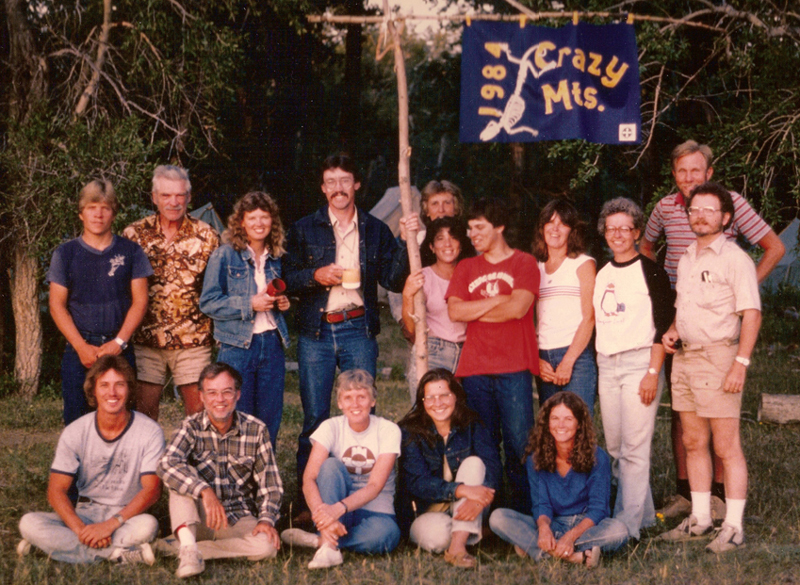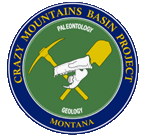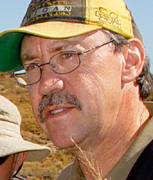In the ten million years following the extinction of dinosaurs, during the Paleocene epoch (ca. 65-55 mya), mammals underwent a major adaptive radiation and became dominant land animals. However, despite the fact that almost one-half of the known orders of Cenozoic mammals arose in the Paleocene, less is known about composition and diversity of mammalian faunas during this time than during any of the later epochs. A large-scale turnover in mammalian faunas, among the most dramatic during the Early Cenozoic, occurred near the middle Paleocene and serves as a basis for splitting the Paleocene into early and late intervals. PRINCIPAL INVESTIGATORS Jon Bloch • Ph.D., Associate Curator of Vertebrate Paleontology, Florida Museum of Natural History; Associate Professor of Geological Sciences, Anthropology, and Zoology, University of Florida. •
Douglas Boyer • Ph.D., Postdoctoral Associate, Department of Ecology and Evolution, Department of Anthropology, Stony Brook University •
Dave Krause • Ph.D., Distinguished Service Professor, Department of Anatomical Sciences, Stony Brook University •
OTHER CURRENT RESEARCH COLLABORATORS Mary Silcox • Ph.D., Asssociate Professor, Department of Anthropology, University of Winnipeg, Winnipeg, Manitoba, Canada •
Elizabeth St. Clair • Ph.D. student, Interdepartmental Doctoral Program in Anthropological Sciences, Stony Brook University •
PUBLICATIONS - CRAZY MOUNTAINS BASIN PROJECT (1982-present, listed alphabetically by author) Anthony, M. R. L., and M. C. Maas. 1990. Biogeographic provinciality in North American Paleocene mammalian faunas. Journal of Vertebrate Paleontology 10:12A. Anthony, M. R. L., M. C. Maas, and D. W. Krause. 1991. New collections of mammals from late Torrejonian localities in the eastern Crazy Mountains Basin, Montana. Journal of Vertebrate Paleontology 11:14A. Archibald, J. D., W. A. Clemens, P. D. Gingerich, D. W. Krause, E. H. Lindsay, and K. D. Rose. 1987. First North American Land Mammal Ages of the Cenozoic Era. Pages 24-76 in M. O. Woodburne (ed.), Cenozoic Mammals of North America, University of California Press, Berkeley. Biknevicius, A. 1985. Dental function and diet in the Carpolestidae (Primates: Plesiadapiformes). Unpublished M.A. thesis, State University of New York at Stony Brook. Biknevicius, A. 1986. Dental function and diet in the Carpolestidae (Primates: Plesiadapiformes). American Journal of Physical Anthropology 71:157-171. Bloch, J. I., D. M. Boyer, and D. W. Krause. 2006. New mammal-bearing quarry from the earliest Tiffanian (early Late Paleocene) of the eastern Crazy Mountains Basin, Montana. Journal of Vertebrate Paleontology 26:43A. Bloch J. I., M. T. Silcox, D. M. Boyer, and E. J. Sargis. 2007. New Paleocene skeletons and the relationship of plesiadapiforms to crown-clade primates. Proceedings of the National Academy of Sciences 104: 1159-1164. Boyer, D. M., and J. I. Bloch. 2003. Comparative anatomy of the pentacodontid Aphronorus orieli (Mammalia, Pantolesta) from the Paleocene of the western Crazy Mountains Basin, Montana. Journal of Vertebrate Paleontology 23:36A. Boyer, D. M., and J. A. Georgi. 2007. Cranial morphology of a pantolestid eutherian mammal from the Eocene Bridger Formation, Wyoming, USA: implications for relationships and habitat. Journal of Mammalian Evolution 14:239-280. Boyer, D. M., A. Evans, J. Jernvall. Accepted pending minor revisions. Evidence of dietary differentiation among late Paleocene-early Eocene plesiadapids (Mammalia, Primates). American Journal of Physical Anthropology. Boyer, D. M., M. Bolortsetseg, J. I. Bloch, and D. W. Krause. In prep. First skeletal remains of a neoplagiaulacid multituberculate (Mammalia: Theriiformes) from the Torrejonian-Tiffanian transition of Montana. Boyer, D. M., J. M. Pares, J. I, Bloch, and D. W. Krause. 2004. Refining intra- and inter-basinal chronostratigraphic correlations of Paleocene mammal-bearing localities in the Crazy Mountains Basin, Montana: Initial paleomagnetic results. Geological Society of America Abstracts with Programs 36(5):363. Buckley, G. A. 1988. A new Purgatorius-like mammal from Simpson Quarry (Puercan), Crazy Mountains Basin, Montana. Journal of Vertebrate Paleontology, Abstracts of Papers 8:10. Buckley, G. A. 1989. A new Puercan species of Catopsalis (Taeniolabididae, Multituberculata) and the evolution of North American taeniolabidids. Journal of Vertebrate Paleontology, Abstracts of Papers 9:14-15. Buckley, G. A. 1993. Magnetostratigraphy of the Late Cretaceous and early-middle Paleocene formations of the Crazy Mountains Basin, Montana. Journal of Vertebrate Paleontology, Abstracts of Papers 13:28. Buckley, G. A. 1994. Paleontology, geology and chronostratigraphy of Simpson Quarry (Early Paleocene), Bear Formation, Crazy Mountains Basin, south-central Montana. Ph.D. dissertation, Department of Geological Sciences, Rutgers University, 459 pp. Buckley, G. A. 1995. Biochronology and magnetostratigraphy of Simpson Quarry (Bear Formation, Crazy Mountains Basin, south-central Montana) and a reassessment of the Puercan NALMA. Geological Society of America, Abstracts with Programs 27(6). Buckley, G. A. 1995. The multituberculate Catopsalis from the early Paleocene of the Crazy Mountains Basin in Montana. Acta Palaeontologica Polonica 40:389-398. Buckley, G. A. 1997. A new species of Purgatorius (Mammalia; Primatomorpha) from the lower Paleocene Bear Formation, Crazy Mountains Basin, south-central Montana. Journal of Paleontology 71:149-155. Buckley, G. A., and D. W. Krause. 1987. Simpson Quarry: the first fossil mammal locality in the lower Paleocene Bear Formation, Crazy Mountains Basin, Montana. Journal of Vertebrate Paleontology, Abstracts of Papers 7:12. Butler, R. F., D. W. Krause, and P. D. Gingerich. 1987. Magnetic polarity stratigraphy and biostratigraphy of middle-late Paleocene continental deposits of south-central Montana. Journal of Geology, 95:647-657. Carlson, S. J. and D. W. Krause. 1982. Multituberculate phylogeny: evidence from tooth enamel ultrastructure. Geological Society of America, Abstracts with Programs, 14:460. Carlson, S. J. and D. W. Krause. 1985. Enamel ultrastructure of multituberculate mammals: an investigation of variability. University of Michigan Museum of Paleontology Contributions, 27:1-50. PDF Dumont, E. R. 1990. Enamel microstructural evidence for the affinities of proposed Early Tertiary archontan taxa. Journal of Vertebrate Paleontology 10:21A. Gingerich, P. D., P. Houde and D. W. Krause. 1983. A new earliest Tiffanian (late Paleocene) mammalian fauna from Bangtail Plateau, western Crazy Mountain Basin, Montana. Journal of Paleontology, 57:957-970. PDF Hartman, J. H., and D. W. Krause. 1993. Cretaceous and Paleocene stratigraphy and paleontology of the Shawmut Anticline and the Crazy Mountains Basin, Montana: Road log and overview of recent investigations. Montana Geological Society -- South-Central Field Conference Guidebook, pp. 71-84. Hartman, J. H., G. A. Buckley, D. W. Krause, and T. J. Kroeger. 1989. Paleontology, stratigraphy, and sedimentology of Simpson Quarry (early Paleocene), Crazy Mountains Basin, south-central Montana. Montana Geological Society, 1989 Field Conference Guidebook, Montana Centennial Edition, D. E. French and R. F. Grabb, eds., vol. II, pp. 173-185. Hartman, J. H., D. W. Krause, G. A. Buckley, and T. J. Kroeger. 1989. Paleocene biochronology in the northern Great Plains: nonmarine Mollusca and Mammalia from the Crazy Mountains Basin. Montana Geological Society, 1989 Field Conference Guidebook, Montana Centennial Edition, D. E. French and R. F. Grabb, eds., vol. I, pp. xxii-xxiii. Krause, D. W. 1984. Mammalian evolution in the Paleocene: Beginning of an era. In T. W. Broadhead (ed.), Mammals: Notes for a Shortcourse. University of Tennessee Department of Geological Sciences Studies in Geology, 8:87-109. Krause, D. W. 1986. Competitive exclusion and taxonomic displacement in the fossil record: the case of rodents and multituberculates in North America. In Vertebrates, Phylogeny, and Philosophy: a Tribute to George Gaylord Simpson (K. M. Flanagan and J. A. Lillegraven, eds.), University of Wyoming Contributions to Geology, Special Paper No. 3:95-117. Krause, D. W. 1987. Baiotomeus, a new ptilodontid multituberculate (Mammalia) from the middle Paleocene of western North America. Journal of Paleontology, 61:595-603. Krause, D. W. 1987. Systematic revision of the genus Prochetodon (Multituberculata, Mammalia) from the late Paleocene and early Eocene of western North America. University of Michigan Museum of Paleontology Contributions, 27:221-236. PDF Krause, D. W. 2004. Systematic revision of the genus Ptilodus (Ptilodontidae, Multituberculata) from the Paleocene of western North America. Journal of Vertebrate Paleontology 24:80A. Krause, D. W. and S. J. Carlson. 1985. The evolution of prismatic enamel in multituberculate mammals. American Society of Mammalogists, Abstracts with Program, p. 9. Krause, D. W. and S. J. Carlson. 1986. The enamel ultrastructure of multituberculate mammals: a review. Scanning Electron Microscopy/1986:1591-1607. Reprinted as pp. 165-180 in L. Martin, A. Boyde, F. Grine, and S. Jones (eds.), Scanning Microscopy of Vertebrate Mineralized Tissues (1988). Scanning Microscopy International, Chicago, 384 pp. Krause, D. W. and S. J. Carlson. 1987. Prismatic enamel in multituberculate mammals: tests of homology and polarity. Journal of Mammalogy, 68:755-765. Krause, D. W., and P. D. Gingerich. 1983. Mammalian fauna from Douglass Quarry, earliest Tiffanian (late Paleocene) of the eastern Crazy Mountain Basin, Montana. University of Michigan Museum of Paleontology Contributions, 26:157-196. Krause, D. W., and M. C. Maas. 1987. Composition and diversity of mammalian faunas across the Torrejonian-Tiffanian boundary in western North America. For symposium volume: "Dawn of the Age of Mammals in the northern part of the Western Interior," T. M. Bown and K. D. Rose, eds. Geological Society of America (Rocky Mountain Section), Abstracts with Program, 19:287. Krause, D. W., and M. C. Maas. 1988. The biogeographic origins of Clarkforkian and Wasatchian mammalian immigrants to the Western Interior. Journal of Vertebrate Paleontology, 8:19A. Krause, D. W., and M. C. Maas. 1990. The biogeographic origins of late Paleocene - early Eocene mammalian immigrants to the Western Interior of North America. In "Dawn of the Age of Mammals in the northern part of the Rocky Mountain Interior, North America." T. M. Bown and K. D. Rose, eds. Geological Society of America, Special Paper 243:71-105. Krause, D. W., and Z. Kielan-Jaworowska. 1993. The endocranial cast and encephalization quotient of Ptilodus (Multituberculata, Mammalia). Palaeovertebrata 22:99-112. Lukowski, S. M., J. I. Bloch, and D. W. Krause. 2004. Several new species of Ectocion from the Crazy Mountains Basin of Montana and stratocladistic analysis of Paleocene Phenacodontidae. Journal of Vertebrate Paleontology 24:86A. Maas, M. C., and D. W. Krause. 1989. Mammalian faunal turnover in North America during the Paleocene. Fifth International Theriological Congress, Abstracts (Symposium on Mammalian Evolutionary Paleoecology), Rome, vol. 2, p. 641. Maas, M. C., and D. W. Krause. 1994. Mammalian turnover and community structure in the Paleocene of North America. Historical Biology 8:91-128. Maas, M. C., D. W. Krause, and S. G. Strait. 1988. The decline and extinction of Plesiadapiformes (Mammalia: ?Primates) in North America: displacement or replacement? Paleobiology, 14:410-431. Maas, M. C., S. Strait, and D. W. Krause. 1987. The decline and extinction of plesiadapiform primates. American Journal of Physical Anthropology, 72:228. Maas, M. C., P. D. Gingerich, G. Gunnell, and D. W. Krause. 1992. Patterns of faunal turnover and diversity in the Wyoming-Montana Paleogene in relation to regional and global events. Fifth North American Paleontological Convention - Abstracts and Program (eds., S. Lidgard and P. R. Crane). The Paleontological Society, Special Publication No. 6:191. Maas, M. C., M. R. L. Anthony, P. D. Gingerich, G. F. Gunnell, and D. W. Krause. 1995 Mammalian generic diversity and turnover in the Late Paleocene and Early Eocene of the Bighorn and Crazy Mountains Basins, Wyoming and Montana (USA). Palaeogeography, Palaeoclimatology, Palaeoecology 115:181-207. Mawyin, C., J. Groenke, D. M. Boyer, and J. I. Bloch. 2004. Novel use for cyclododecane in acid preparation of recently recovered Paleocene limestones from the western Crazy Mountains Basin, Montana. Journal of Vertebrate Paleontology 24:90A-91A. McCullough, G. M., M. T. Silcox, J. I. Bloch, D. M. Boyer, and D. W. Krause. 2004. New palaechthonids (Mammalia, Primates) from the Paleocene of the Crazy Mountains Basin, Montana. Journal of Vertebrate Paleontology 24:91A. Scott, C. S., and D. W. Krause. 2006. Multituberculates (Mammalia, Allotheria) from the earliest Tiffanian (Late Paleocene) Douglass Quarry, eastern Crazy Mountains Basin, Montana. University of Michigan Museum of Paleontology Contributions 31(10):211-243. PDF Silcox, M. T., D. W. Krause, M. C. Maas, and R. C. Fox. 2001. New specimens of Elphidotarsius russelli (Mammalia, ?Primates, Carpolestidae) and a revision of plesiadapoid relationships. Journal of Vertebrate Paleontology 21:132-152. St. Clair, E., D. W. Krause, and D. B. Boyer. 2005. Pantodonts (Mammalia) from the early Tiffanian (Paleocene) of the Crazy Mountains Basin, Montana. Journal of Vertebrate Paleontology 25:118A. St. Clair, E., D. M. Boyer, J. I. Bloch, and D. W. Krause. 2008. New records of Goniacodon levisanus (Mammalia, Triisodontinae) from the late Paleocene of the Crazy Mountains Basin, Montana. Journal of Vertebrate Paleontology 28:147A. St. Clair, E. M., D. M. Boyer, J. I. Bloch, and D. W. Krause. In press. First records of a triisodontine mammal, Goniacodon levisanus, in the late Paleocene of the northern Great Plains, North America. Journal of Vertebrate Paleontology. Strait, S. G. 1990. Food consistency and the dental morphology of extant faunivorous mammals: implications for reconstructing diet in the fossil record. Journal of Vertebrate Paleontology 10:44A. Strait, S. G. 1991. Molar microwear in small-bodied faunivorous mammals. Journal of Vertebrate Paleontology 11:57A. Strait, S. G., and D. W. Krause. 1988. New Paleocene fossils from the Crazy Mountains Basin, Montana: implications for plesiadapid (Mammalia, ?Primates) systematics and biochronology. Journal of Vertebrate Paleontology 8:27A. Thewissen, J. G. M. 1990. Evolution of Paleocene and Eocene Phenacodontidae (Mammalia, "Condylarthra"). University of Michigan Papers on Paleontology 29:1-107. Wall, C. E. 1990. Biomechanical correlates of inferred feeding behavior in Ptilodus (Multituberculata). Journal of Vertebrate Paleontology 10:47A. Wall, C. E., and D. W. Krause. 1992. A biomechanical analysis of the masticatory apparatus of Ptilodus (Multituberculata). Journal of Vertebrate Paleontology 12:172-187. Watters, J. P. and D. W. Krause. 1986. Plesiadapid primates and biostratigraphy of the North American late Paleocene. American Journal of Physical Anthropology, 69:277. Weil, A., and D. W. Krause. 2008. Chapter 2: Multituberculata. Pp. 19-38 in C. M. Janis, G. F. Gunnell, and M. D. Uhen (eds.), Evolution of Tertiary Mammals of North America. Volume 2: Small Mammals, Xenarthrans, and Marine Mammals. Cambridge University Press, Cambridge, UK. Zack, S., T. Penkrot, D. W. Krause, and M. C. Maas. 2005. A new apheliscine "condylarth" from the Tiffanian (Late Paleocene) of Montana and Alberta, and the phylogeny of "hyopsodontids." Acta Palaeontologica Polonica 50(4):809-830. |

|





